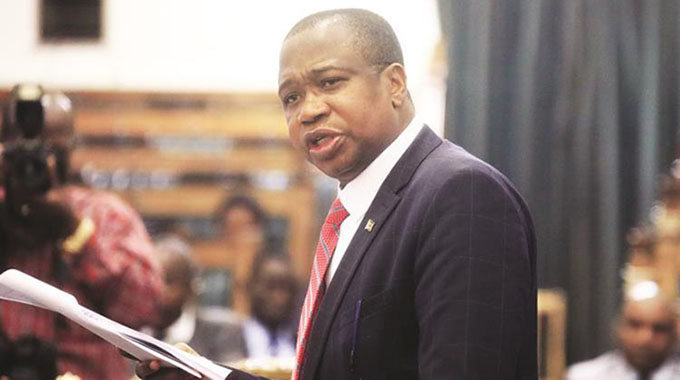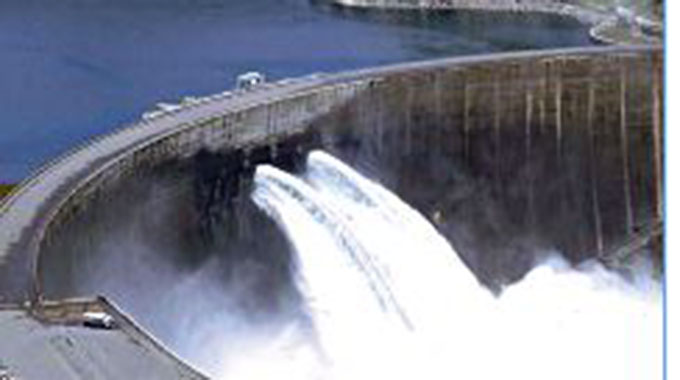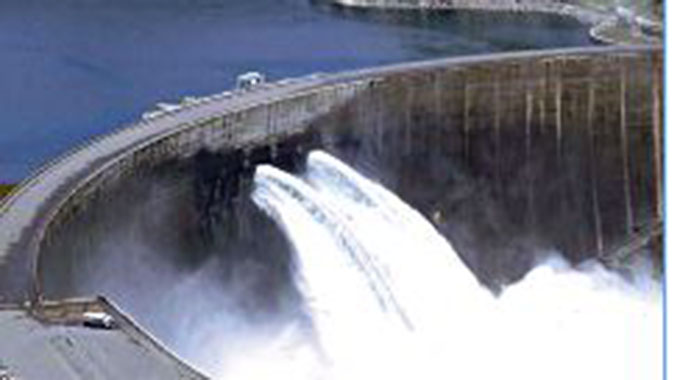2019: Smoothing bumpy road to prosperity

Lawson Mabhena,News & Political Editor
President Mnangagwa’s inauguration speech following the peaceful transition that ushered in the new political dispensation in November 2017 is widely known as the “Zimbabwe is open for business” speech.

Key power projects targeted by the Government include Kariba Dam rehabilitation
Economic recovery was at the centre of not only the speech, but also the expectations and aspirations of all Zimbabweans after almost two decades of slumber.
The President was quick to lay out economic direction and hit the ground running in a bid to forge a new work ethic that would be critical to the recovery of the national economy.
Optimisation of natural resources, ending corruption, implementation of reforms and economic diplomacy were part of the radical economic transformation that would propel the country to middle-income status by 2030.
According to the World Bank, a middle-income economy is one with a gross national income ranging between US$1 005 and US$12 235 per capita.
Currently, the World Bank classifies Zimbabwe as a low-income economy.
Zimbabwe’s roadmap to a middle-income economy — Vision 2030 — is anchored on four clusters: governance; macro-economic stability and financial re-engagement; inclusive growth, infrastructure and utilities; social development and cross cutting themes.
The foundation laid by the President in his inauguration speech was firm, concise and realistic.
“Our economic policy will be predicated on our agriculture, which is the mainstay, and on creating conditions for an investment-led economic recovery that puts premium on job-creation.
Key choices will have to be made to attract foreign direct investment (FDI) to tackle high levels of unemployment while transforming our economy towards the tertiary.
The many skilled Zimbabweans who have left the country over the years for a variety of reasons must now come into the broad economic calculus designed for our recovery and take off,” the President said.
“Of course, the physical and social infrastructure must be repaired and expanded to position our country in readiness for economic growth, employment creation, equity, freedom and democracy, and for the provision of vital social goods, principally health, shelter, clean water, education and other key social services.”
To realise Vision 2030, Government set out three crucial plans: the Transitional Stabilisation Programme (TSP) (September 2018 – December 2020), First five-year National Development Plan (2021-2025) and Second five year National Development Plan (2026-2030).
Currently, Government is implementing TSP, which focuses on stabilising the macro-economy and laying a foundation for sustainable and shared private sector-led growth.
The neo-liberal turn
To become a middle-income economy, reforms had to be implemented to promote economic liberalisation. The reforms covered privatisation, deregulation, free trade, austerity, and reductions in
Government spending.
A number of laws have since been aligned with the Constitution, a process coordinated by an Inter-Ministerial Taskforce.
To effectively enhance governance monitoring activities, Government successfully established and operationalised the National Prosecuting Authority as well as the Human Rights, National Peace and Reconciliation, Anti-Corruption, Electoral, Gender, Land, Media, and Judicial Service commissions.
Laws restricting freedoms are being repealed under the Second Republic.
The Public Order and Security Act (POSA) has been replaced by the Maintenance of Peace and Order Act (MOPA), while the Access to Information and Protection of Privacy Act (AIPPA) was replaced by three pieces of legislation — the Zimbabwe Media Commission Act, Freedom of Information Act, and Protection of Personal Information/Data Act.
The Police Amendment Bill, which is still being processed, seeks to transform the Zimbabwe Republic Police into the Zimbabwe Police Service, with officers already having undergone relevant training.
Essentially, the principle is that economies thrive where democracy thrives. The opening up of democratic space in the Second Republic was the first step towards rebuilding the economy.
The return of the Zimbabwe dollar
For any economy to function, a stable currency is needed.
Government in July removed the multi-currency regime and restricted domestic transactions to local currency, renamed Zimbabwe dollar, in an effort to enhance the affordability of goods and services by the majority.
Finance and Economic Development Minister Professor Mthuli Ncube said Government had taken the decision to abandon the multi-currency system after noting that the market was choosing to price a number of goods and services in US dollars when the majority of citizens earned the local unit.
Later, the Reserve Bank of Zimbabwe (RBZ) introduced new bank notes and coins to be used together with bond notes.
Statutory Instrument 142 of 2019 designated the Zimbabwe dollar, defined as made up of electronic deposits (RTGS), bond notes and coins, as the sole legal tender for all domestic transactions.
The new notes and coins fall also under the “Zimbabwe dollar” designation.
“The multiple currency regime served its purpose in stabilising the economy through dampening inflation.
However, the monetary system lacked flexible utilisation of a full set of monetary instruments to influence economic activity.
In addition, the adoption of a hard and strong currency such as the US dollar, compromised competitiveness of local companies.
“It is with this view that Government took a deliberate gradual approach for transiting from the multiple currency system to mono-currency,” reads a report from the Ministry of Finance and Economic Development.
According to the report, the process of introducing a mono currency was a three-step process entailing:
The separation of the foreign Nostro accounts from RTGS-denominated accounts as announced during the October 2018 Monetary Policy Statement.
The establishment of the RTGS dollar comprising of electronic balances in banks and mobile platforms, bond notes and coins as announced during the Monetary Policy Statement of 20 February 2019 (SI 33 of 2019);.
The Introduction of the Zimbabwe dollar on June 24, 2019. Under the new framework, all domestic transactions are now settled in Zimbabwe dollars, the sole legal tender represented by bond notes and coins and electronic currency, that is RTGS dollars. All other currencies from the multi-currency regime serve as reserve currencies.
Infrastructure rehabilitationand development
To achieve economic growth, infrastructure is key. Obsolete infrastructure had played a role in economic demise as key sectors rely on functional systems.
Key power projects targeted by Government include Hwange Power Station (7 and 8), Kariba Dam
Rehabilitation and Batoka Gorge Hydro-Electric Project.
Zimbabwe requires 2 200MW, but is currently generating far less than that.
The Hwange plant’s installed production potential will rise to 1 520MW once the extension project has been completed, while the 300 megawatt extension of Kariba South will add to the existing 750MW capacity.
The Zimbabwe Energy Regulatory Authority (Zera) has processed 39 solar power projects that have capacity to generate up 1 151,87MW, as the country moves towards renewable energy to contain shortages.
According to Zera, 60 licensed independent power producers have a combined installed capacity of at least 6 700 megawatts.
Water augmentation projects include Marovanyati, Gwayi-Tshangani, Chivhu and Causeway dams, with Government setting aside 200ha for irrigation in every district.
Other urban water projects include, Semwa, Bindura and Tuli-Manyange dams, Victoria Falls Municipality Water and Sanitation Project and the Chiredzi Town Council water and waste-water augmentation.
Last year, Government invited investors to construct 50 dams for the generation of hydroelectricity under the Build Operate and Transfer arrangement.
To facilitate the transportation of goods and travellers, the Harare-Beitbridge, Harare-Mutare highways are being dualised, while Robert Gabriel Mugabe International Airport is being expanded.
Treasury-funded road construction projects went up last year by over 200 percent compared to the previous political administration, and at least 50 percent when compared to the Rhodesian administration.
High grade asphalt concrete roads are being constructed to facilitate the movement of goods on major highways, while the National Railways of Zimbabwe’s recapitalisation and rehabilitation of the rail road network will reduce the load on the country’s roads.
On the social services front, refurbishment of district, provincial and central hospitals has either been completed or is almost complete.
Parastatal and public enterprise reform
Government has recorded considerable progress in reforming State-owned enterprises.
The reform framework, as espoused in the TSP, seeks, among other reasons, to mobilise private sector capital, technology and expertise to enhance efficiency and the effectiveness of public entities in the delivery of goods and services.
Part of the plan under the reforms includes earmarking State-owned enterprises for:
privatisation: Infrastructure Development Bank, Zupco, Agribank, some subsidiaries of the Industrial
Development Corporation listing on Zimbabwe Stock Exchange: Petrotrade, Willovale Motor Industries, Chemplex and Deven Engineering.
Mergers: Portraz and Broadcasting Authority of Zimbabwe; Powertel, Zarnet and Africom; Boxing and Wrestling Boards; Competition and Tariffs Commission; ZIA, Special Economic Zones, Zimtrade and Joint Ventures Unit.
Liquidation: National Glass Industries, Zimglass, Kingstons Limited, Tractot Firm Motira
adoption by line ministries: ZIA, NIEEB, National Liquor Licensing, Board of Censors, Lotteries and Gaming Board.
Partial privatisation: 17 Zimbabwe Mining Development Corporation subsidiaries, Grain Marketing Board and Civil Aviation Authority of Zimbabwe rebundling: ZESA Holdings.
Ease of doing business
Government continues to pursue Ease of Doing Business Reforms as part of broad measures on enhancing the country’s investment environment and external competitiveness.
The reforms target administrative and other legislative bottlenecks under various statutes.
With regards to administrative procedures, timelines and costs have been reviewed and streamlined to facilitate the Ease of Doing Business.
The 2019 World Bank Doing Business Report identified Zimbabwe as one of the top 20 on the world and top five in Africa doing business reformers.
The country was noted to have made improvements in the five areas of:
Starting a Business (from 32 to 11 days)
Harare Municipality fees (US$300 to $3 000)
Dealing with construction permits (208 to 150 days)
Registering of property (36 to 14 days)
A number of laws have been enacted to facilitate Ease of Doing Business.
This is in keeping with Government’s pronouncement that 13 laws will be promulgated to create a conducive investment climate by addressing concerns previously raised by foreign investors. Some of the
Bills include the National Competitiveness Commission Bill, the State Procurement Bill, Judiciary Laws Amendment Bill and the Shop Licences Amendment Bill.
The Zimbabwe Investment Development Agency Bill, which will facilitate the establishment of the one-stop-shop investment centre, is awaiting Presidential consent.
Challenges
As a result of unprecedented climate and economic shocks, the humanitarian needs unfortunately increased in Zimbabwe.
Drought compromised agricultural activities and electricity generation, while Cyclone Idai put Government off budget.
Shortages of foreign currency had ripple effects on various production sectors and this was also compounded by Western-imposed sanctions.
Fuel queues and electricity cuts became the order of the day in 2019, although Government is seeking long-term solutions.
Responding to Minister Ncube’s 2020 National Budget Statement presentation last month, economist Mr Persistence Gwanyanya said Zimbabwe carries a burden of the past.
“While there appears to be understanding of the urgency of economic reforms by Treasury, it seems we underestimated the depth of our challenges, ostensibly because we suppressed the economy for too long, through unsustainable subsidies, including currency subsidies; exchange rate parity (1:1) and managed foreign currency allocation system.
“All these are stop-gap measures, short-term fixes and half-baked solutions, which, ironically, got us nowhere, but deeper into the hole. It’s unsurprising that we missed all key macro-economic targets in 2019 as the economy adjusted to its true position following the implementation of economic reforms, which started in October last year,” he said.
End of austerity
The Ministry of Finance and Economic Development has said the country is “gradually exiting from austerity measures by switching to reforms that emphasise on growth, productivity and prosperity objectives”.
Remaining reforms must be concluded while productivity must be enhanced to address the issue of forex shortages once and for all.
The envisaged US$12 billion mining industry, launch of ZIDA and a lasting solution to fuel and power shortages should mark the conclusion of TSP in December 2020.








Comments